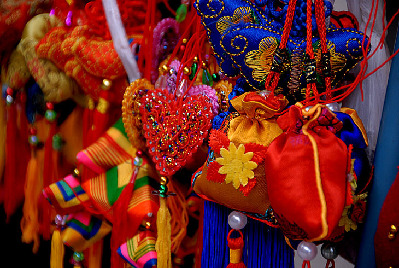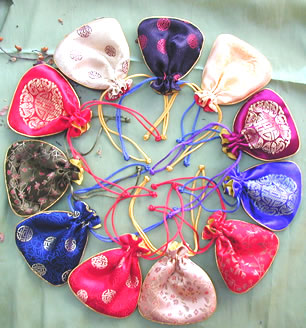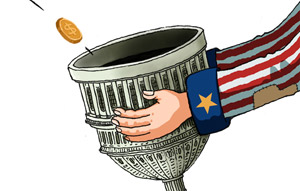The culture of Chinese small living goods
Updated: 2013-06-07 15:07
(chinaculture.org)
|
||||||||
Chinese Perfume Pouch

The history of the Chinese perfume pouch (commonly called Xiangbao, Xiangnang, Xiangdai or Hebao) can be traced back to the Duanwu Festival, or Dragon Boat Festival, which falls on the 5th day of the 5th lunar month. It is said that people in ancient times used to carry a medicine bag while hunting, to drive out poisonous insects. Today we still see some old men carry on them a bag in the shape of calabash, a custom that can probably be traced back to this old tradition.
Another old saying goes that when Qu Yuan, the great poet of the Chu state during the Warring States Period, drowned himself in Miluo River on the 5th day of the 5th lunar month, people in the neighboring Qin, out of sympathy for him and to cherish his memory, made and carried a pouch stuffed with sweet grass and perfumes that he had loved.
Some people say carrying the pouch was a long-standing custom of the Han people; its origin can be traced back to the Tang Dynasty, when women in the rural areas would in the 4th lunar month each year begin to make perfume pouch with colored silk, silk threads and gold and silver beads. By the Qing Dynasty, perfume pouch was carried by people not only on the Dragon Boat Festival, but every day, because the Manchus had long had that custom. According to the a Qing Dynasty custom, emperors and empresses were required to carry perfume pouch on them all year round and at the end of every year, or on important festivals, the emperor would award the princes and ministers each a perfume pouch to show his favor for them. More interestingly, perfume pouches were used by Emperor Tongzhi and Emperor Guangxu to choose their empresses: the girls would line up to be examined by the Emperor, who would hang a perfume pouch on the button on the dress of the girl to whom he took a fancy.

Common people make an even more extensive use of the perfume pouch. Men and women, old and young all can carry one on them and present it to others as a gift. There are many descriptions of this practice in the Chinese classic novel A Dream of Red Mansions. Some young men and women often use it as a token of love. There is a Yu opera, Story of a Perfume Pouch, which tells the story of a married couple who have been separated and have heard no news of each other for years but one day finally come together and are reunited—with the help of a perfume pouch.
Of course, as the development of human society and the advance of science march forever forward, the perfume pouch loses some of its original functions. But it remains in the favor of many. It takes a wide variety of shapes, but whatever shape it takes is always small and exquisite and has a pleasing fragrance. It not only is a delicate work of art, but also has some preventive power against diseases. Among young people in the countryside, it is still a valued gift to be exchanged between lovers. Decorations range from floral and small animals (such as birds and fish) designs to patterns of musical instruments, books, utensils and romantic figures, depending on the maker's aesthetic taste.

 Victoria Beckham S/S 2014 presented during NYFW
Victoria Beckham S/S 2014 presented during NYFW
 'Despicable' minions upset Depp's 'Lone Ranger' at box office
'Despicable' minions upset Depp's 'Lone Ranger' at box office
 'Taken 2' grabs movie box office crown
'Taken 2' grabs movie box office crown
 Rihanna's 'Diamonds' tops UK pop chart
Rihanna's 'Diamonds' tops UK pop chart
 Fans get look at vintage Rolling Stones
Fans get look at vintage Rolling Stones
 Celebrities attend Power of Women event
Celebrities attend Power of Women event
 Ang Lee breaks 'every rule' to make unlikely new Life of Pi film
Ang Lee breaks 'every rule' to make unlikely new Life of Pi film
 Rihanna almost thrown out of nightclub
Rihanna almost thrown out of nightclub
Most Viewed
Editor's Picks

|

|

|

|

|

|
Today's Top News
Going green can make good money sense
Senate leader 'confident' fiscal crisis can be averted
China's Sept CPI rose 3.1%
No new findings over Arafat's death: official
Detained US citizen dies in Egypt
Investment week kicks off in Dallas
Chinese firm joins UK airport enterprise
Trending news across China
US Weekly

|

|







